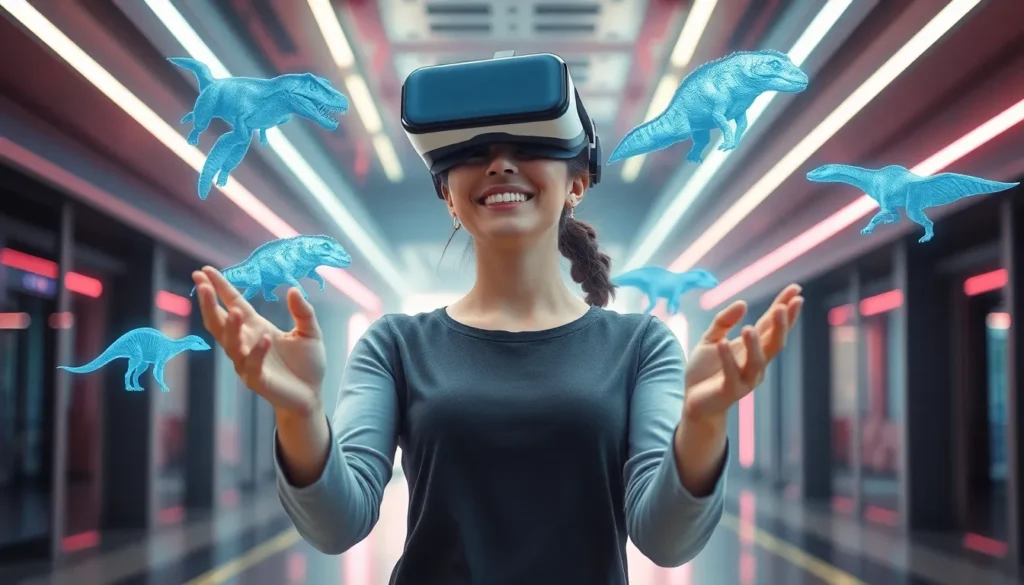In a world where reality sometimes feels a bit too mundane, virtual reality (VR) and augmented reality (AR) swoop in like superheroes ready to save the day. Imagine slipping on a headset and finding yourself in a lush, alien landscape or whipping out your phone to see a dinosaur casually chilling in your living room. Sounds exciting, right? But what’s the real difference between these two tech marvels?
Table of Contents
ToggleWhat Is Virtual Reality?
Virtual reality immerses users in a computer-generated environment that simulates real or imagined worlds. This technology creates an experience that feels tangible and interactive, allowing users to engage with their surroundings.
Definition of Virtual Reality
Virtual reality refers to a simulated experience that can replicate or enhance the physical world. Users typically wear headsets equipped with screens, which create a 3D visual experience. By utilizing motion sensors and audio, VR technology enables users to explore virtual environments as if they were actually present. This engagement often leads to heightened emotional responses, making activities such as gaming and training more impactful.
Key Features of Virtual Reality
Key features of virtual reality distinguish it from other technologies. First, immersion allows users to feel as though they are entirely within a digital space, promoting a sense of presence. Interaction enhances user experiences by enabling them to manipulate virtual objects with hand controllers or gestures. A strong aspect of VR is its adaptability across various fields, including education, healthcare, and entertainment. Additionally, social experiences enable users to connect with others within virtual settings, enhancing collaboration or entertainment opportunities.
What Is Augmented Reality?

Augmented reality (AR) superimposes digital information onto the physical world, enhancing the user’s perception of their environment. AR integrates computer-generated images, sounds, and other data into real-world settings.
Definition of Augmented Reality
Augmented reality is a technology that combines digital content with the real world, allowing users to interact with both. Devices such as smartphones and AR glasses facilitate this blend by overlaying graphics, sounds, and other sensory inputs. Unlike virtual reality, which creates an entirely artificial environment, AR enhances existing environments without replacing them. Popular applications include interactive gaming and navigation tools that provide contextual information alongside real-world objects.
Key Features of Augmented Reality
Key features of augmented reality include real-time interaction, 3D visualization, and environment recognition. Real-time interaction allows users to engage with digital elements instantly as they explore their surroundings. 3D visualization ensures that digital content appears in a spatial context, seamlessly integrating with real-life objects. Environment recognition involves the system identifying physical objects or spaces, offering relevant information based on user interactions. This technology finds applications in diverse fields such as retail, education, and healthcare, where it enhances user experience and provides valuable insights.
Comparing Virtual Reality and Augmented Reality
Virtual reality (VR) and augmented reality (AR) share a fundamental goal: enhancing user experience through technology. Both create engaging interactions, whether by immersing users in digital worlds or overlaying digital elements onto their surroundings.
Similarities Between Both Technologies
Both VR and AR utilize advanced technology to create unique experiences. Each employs computer-generated graphics to enrich user engagement and rely on high-quality visuals for effective communication. Real-time interaction characterizes both, enabling users to respond dynamically to their environments. Furthermore, VR and AR find applications across similar fields, including education and healthcare, where they enhance learning and training experiences.
Differences Between Both Technologies
Virtual reality immerses individuals in a completely digital environment, isolating them from the physical world. Contrarily, augmented reality overlays digital information onto the real-world landscape, blending the two effectively. Users typically don headsets for VR, while AR often utilizes smartphones or tablets for access. Immersion defines VR, creating a strong sense of presence, whereas interaction in AR focuses on enhancing real-world experiences, allowing users to engage with both physical and digital elements concurrently.
Applications of Virtual Reality and Augmented Reality
Virtual reality and augmented reality each have unique applications that showcase their capabilities across various sectors.
Virtual Reality Use Cases
Educational institutions leverage virtual reality to create immersive learning experiences. Medical training programs use VR for realistic simulations, allowing students to practice procedures without risk. Entertainment industries incorporate VR to deliver engaging gaming experiences, drawing players into lifelike environments. Real estate professionals showcase properties through virtual tours, enabling potential buyers to explore homes from anywhere. Businesses also utilize VR for training and development, enhancing employee engagement with interactive modules.
Augmented Reality Use Cases
Retailers adopt augmented reality to enhance shopping experiences. Customers can visualize how furniture fits within their homes using AR apps. Healthcare professionals implement AR for surgical guidance, overlaying vital information during procedures. Museums and galleries employ AR to provide interactive experiences, enriching visitor engagement with supplementary digital content. Navigation apps utilize augmented reality to provide real-time directions, seamlessly integrating digital information into the physical landscape.
Virtual reality and augmented reality each offer unique experiences that cater to different user needs. VR immerses users in entirely digital worlds, providing a sense of presence that transforms how they interact with content. In contrast, AR enhances the real world by overlaying digital information, allowing for a seamless blend of physical and virtual elements.
As these technologies continue to evolve, their applications in various fields will expand, driving innovation and enhancing user engagement. Understanding the distinctions between VR and AR is crucial for anyone looking to explore the potential of these transformative technologies.








